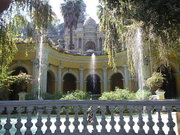
Cerro Santa Lucía
Encyclopedia

Santiago, Chile
Santiago , also known as Santiago de Chile, is the capital and largest city of Chile, and the center of its largest conurbation . It is located in the country's central valley, at an elevation of above mean sea level...
. It borders on Alameda del Libertador Bernardo O'Higgins
Alameda del Libertador Bernardo O'Higgins
Avenida Libertador General Bernardo O'Higgins , popularly known as La Alameda , is Santiago, Chile's main avenue. It runs east-west in the center of the greater urban area and is 15 km long, and it has 5 lanes in each direction. It was named after Chile's founding father Bernardo O'Higgins...
in the south, Santa Lucía Street in the west and Victoria Subercaseaux on the east. An adjacent metro
Santiago Metro
Metro de Santiago is South America's most extensive metro system with 5 lines, 108 stations and 103 kilometres of track making it the second longest in Latin America after that of Mexico City. The metro system serves the city of Santiago, Chile. Three of the lines are rubber-tyred...
station is named for it. The hill has an altitude of 629 m and a height of 69 m over the surrounding area. The hill is the remnant of a volcano 15 million years old.
The hill is adorned with ornate facades, stairways and fountains. Atop the hill, there is a viewpoint unsurpassed inside Santiago except by Cerro San Cristóbal
Cerro San Cristóbal
Cerro San Cristóbal is a hill in northern Santiago, Chile. It rises 880 m AMSL and about 300 m above the rest of Santiago; the peak is the second highest point in the city, after Cerro Renca. Its original indigenous name was Tupahue...
. It is a frequent spot for tourists visiting the city.
History
It was originally called Huelén by the pre-colonization inhabitants; in MapudungunMapudungun
The Mapuche language, Mapudungun is a language isolate spoken in south-central Chile and west central Argentina by the Mapuche people. It is also spelled Mapuzugun and sometimes called Mapudungu or Araucanian...
the word means "pain, melancholy or sadness". However, the current name comes from the day in which Pedro de Valdivia
Pedro de Valdivia
Pedro Gutiérrez de Valdivia or Valdiva was a Spanish conquistador and the first royal governor of Chile. After serving with the Spanish army in Italy and Flanders, he was sent to South America in 1534, where he served as lieutenant under Francisco Pizarro in Peru, acting as his second in command...
conquered the hill, on December 13, 1541. That day celebrates "Santa Lucía."
Its first use by its conquerors was as a point of reconnaissance, or a lookout in the years of the Conquista (1541).
On one side of the hill, Fort Hidalgo was built in 1820 as a defensive point.
On the other side, the hillside terrain was used as a "cemetery for the dissidents", people who did not follow the then-official Roman Catholic faith, or were considered otherwise unworthy of burial at hallowed grounds. However, the remains buried in the hillside under this fashion were eventually transferred to a secluded section of the General Cemetery, before said cemetery, in turn, was opened to all burials regardless of creed or social condition.
In 1872 Benjamín Vicuña Mackenna
Benjamín Vicuña Mackenna
Benjamín Vicuña Mackenna was a Chilean writer, journalist, historian and politician. Vicuña Mackenna was of Irish and Basque descent.-Biography:...
decided to conduct a dramatic change to the urban atmosphere of the city of Santiago, among his many works aimed to improve the city, and thus initiated an extensive remodelation of the hill.
The works of 1872 consisted of a road which crossed the hill, which at the top accessed a chapel which he also built there, illuminated by the then-novel means of gas. The rest of the hill contains a park with fountains and lookouts. The actual hill is watered by a sophisticated irrigation system. The now iconic yellow and white facade is also a product of Vicuña Mackenna's remodelation.
Vicuña Mackenna was assisted in realizing his designs by the architect Manuel Aldunate, the constructor Enrique Henes, and the stonecutter Andrés Staimbuck.
A few years ago, Santa Lucía hill received an improvement in its illumination system and protections. Also, Fort Hidalgo was restored and reopened to the public. Traditionally, a cannon shot was fired exactly at noon. However, this custom has been abandoned in recent years.
Curiosity
Located in Santa Lucía Hill there is a monument which consists of a 2 m high stone carved with a paragraph extracted from the text that Pedro de ValdiviaPedro de Valdivia
Pedro Gutiérrez de Valdivia or Valdiva was a Spanish conquistador and the first royal governor of Chile. After serving with the Spanish army in Italy and Flanders, he was sent to South America in 1534, where he served as lieutenant under Francisco Pizarro in Peru, acting as his second in command...
sent to the Emperor Carlos V describing the features of the new land conquered.

